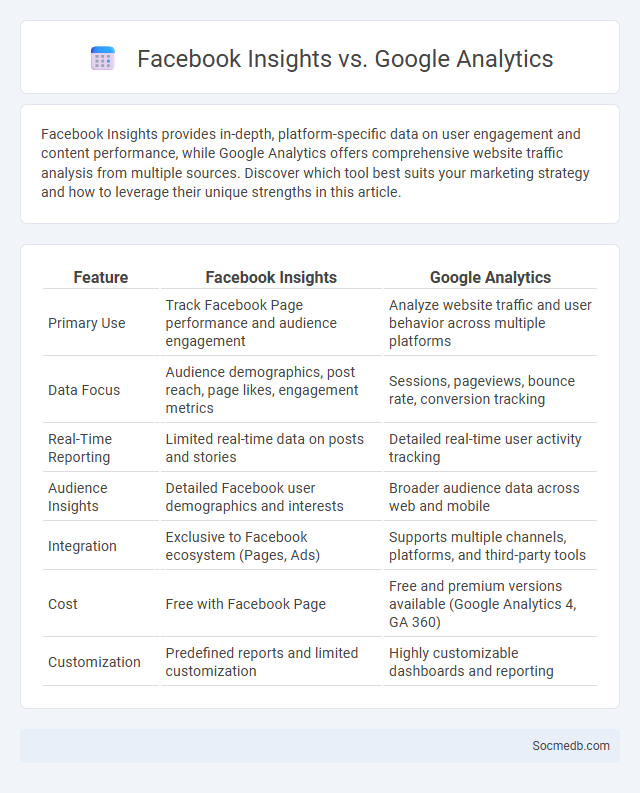
Photo illustration: Facebook Insights vs Google Analytics
Facebook Insights provides in-depth, platform-specific data on user engagement and content performance, while Google Analytics offers comprehensive website traffic analysis from multiple sources. Discover which tool best suits your marketing strategy and how to leverage their unique strengths in this article.
Table of Comparison
| Feature | Facebook Insights | Google Analytics |
|---|---|---|
| Primary Use | Track Facebook Page performance and audience engagement | Analyze website traffic and user behavior across multiple platforms |
| Data Focus | Audience demographics, post reach, page likes, engagement metrics | Sessions, pageviews, bounce rate, conversion tracking |
| Real-Time Reporting | Limited real-time data on posts and stories | Detailed real-time user activity tracking |
| Audience Insights | Detailed Facebook user demographics and interests | Broader audience data across web and mobile |
| Integration | Exclusive to Facebook ecosystem (Pages, Ads) | Supports multiple channels, platforms, and third-party tools |
| Cost | Free with Facebook Page | Free and premium versions available (Google Analytics 4, GA 360) |
| Customization | Predefined reports and limited customization | Highly customizable dashboards and reporting |
Overview of Facebook Insights, Google Analytics, and Instagram Insights
Facebook Insights offers detailed analytics on page performance, including user demographics, post engagement, and reach, enabling businesses to tailor content effectively. Google Analytics tracks website traffic, user behavior, and conversion metrics, providing valuable data for optimizing marketing strategies and measuring social media impact. Instagram Insights delivers metrics on follower activity, post interactions, and story performance, helping brands refine content and increase audience engagement.
Key Features Comparison
Social media platforms offer diverse key features tailored to different user needs, such as Facebook's robust community groups, Instagram's visual-centric content sharing, and Twitter's real-time news updates and microblogging. Your choice should consider features like user interface, privacy controls, content formats, and engagement tools, which vary significantly across platforms. Understanding these differences helps optimize your social media strategy for better connectivity and audience reach.
Data Collection Methods
Social media platforms utilize various data collection methods including user-generated content analysis, behavioral tracking, and metadata aggregation to gather detailed insights about user preferences and interactions. These methods involve monitoring likes, shares, comments, and time spent on posts, combined with location data and device information to create comprehensive user profiles. Advanced algorithms process this data to enhance targeted advertising, content personalization, and trend prediction on social media networks.
Audience Demographics & Segmentation
Social media platforms provide extensive tools for Audience Demographics & Segmentation, allowing businesses to target users based on age, gender, location, interests, and behavior. Detailed insights into user engagement and psychographic data enable precise ad customization and content personalization, maximizing campaign effectiveness. Leveraging segmentation models such as lookalike audiences and retargeting enhances the ability to reach niche markets and improve conversion rates.
Traffic Sources & Attribution
Understanding traffic sources and attribution in social media is crucial for maximizing your marketing efforts. Analyzing data from platforms like Facebook, Instagram, and Twitter helps identify which channels drive the most engagement and conversions. By accurately attributing user actions to specific campaigns, you can optimize your strategy and improve ROI.
Content Performance Metrics
Content performance metrics on social media include engagement rate, reach, impressions, and click-through rate (CTR), providing insights into how users interact with posts. Analyzing metrics such as likes, shares, comments, and video views helps optimize content strategy to boost organic growth. Monitoring conversion rates and follower growth over time supports data-driven decisions to enhance audience targeting and overall campaign effectiveness.
Engagement Tracking and Analysis
Engagement tracking and analysis on social media platforms provide critical insights into your audience's behavior, preferences, and interaction patterns. By monitoring metrics such as likes, shares, comments, and click-through rates, you can optimize content strategies to boost visibility and foster community growth. Leveraging advanced analytics tools enables you to identify high-performing posts, track campaign effectiveness, and enhance overall user engagement for measurable business outcomes.
Reporting & Dashboard Visualization
Social media reporting and dashboard visualization provide real-time insights into your campaign performance, enabling data-driven decision-making. Customizable dashboards consolidate metrics such as engagement rates, follower growth, and post reach, offering a comprehensive overview at a glance. Leveraging these tools helps optimize content strategy by identifying top-performing posts and audience trends effectively.
Integration with Other Platforms
Social media integration with other platforms enhances your marketing strategy by seamlessly connecting content across websites, apps, and email campaigns. Tools like login APIs, social sharing buttons, and cross-platform analytics streamline user engagement and increase brand visibility. Leveraging such integrations drives higher traffic, improves user experience, and boosts conversion rates effectively.
Choosing the Right Analytics Tool for Your Needs
Selecting the right social media analytics tool is crucial for accurate insights into engagement, reach, and audience demographics. You should consider platforms like Hootsuite, Sprout Social, or Google Analytics based on your content goals, budget, and preferred metrics. An optimized tool enhances your ability to track campaign performance and refine your social strategy effectively.
 socmedb.com
socmedb.com